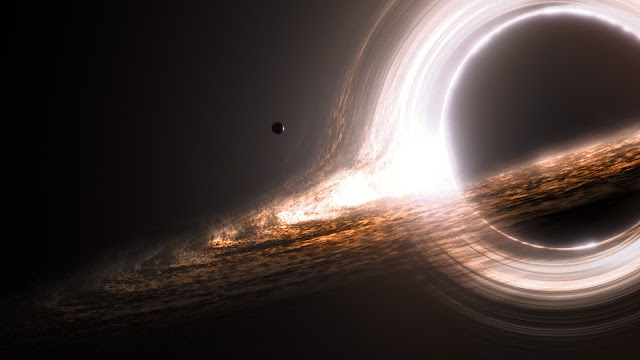Long after the last stars fade, a dazzling display of fireworks will announce the end of the universe.
Black holes are areas of space-time where gravity reigns supreme: A black hole's gravitational pull is so powerful that nothing, not even light, can escape. They range in size from stellar-mass black holes with masses ranging from five to 100 times that of the Sun to supermassive black holes with masses exceeding a billion solar masses. Astronomers currently believe that supermassive black holes exist at the centre of most galaxies. (A major exception to this norm is M33, which appears to lack a centre supermassive black hole despite being the third largest member of our Local Group.)
The cosmos is currently in its Stelliferous Era, when stars and galaxies are constantly being born. The chemicals required to create these things will eventually run out, and the stars in the night sky will gradually fade away, leaving just black holes as the universe's occupants.
Even black holes will die one day. When they do, these monsters will not go quietly into the night. In the dying seconds of each black hole, a burst of fireworks will light up the universe, signaling the end of an era.
Death is being cheated
Black holes thrive by consuming the gas and stars that surround them, and their greed is what gives them away. They are frequently surrounded by accretion rings of material that they have ripped apart and pulled close, like water swirling down a drain. As material approaches the black hole, it begins to travel faster and faster, piling up around it. Friction among the dust generates heat, causing the accretion disc to flare and shape the black hole's shadow — or event horizon. "It wants to hide, but it does a really lousy job of it sometimes," says Sheperd Doeleman, a Harvard University black hole researcher and the director of the Event Horizon Telescope, which took the first snapshot of a black hole in 2019.
The event horizon not only identifies a black hole, but it is also the key to a black hole's demise.
Nothing can escape the grasp of these gluttonous beasts, thus anything that crosses the horizon of a black hole is gone forever. That is, at least, what our current understanding of gravity suggests. However, this so-called point of no return ignores quantum mechanics. (Physicists are still working on a unifying theory of quantum gravity.) Stephen Hawking demonstrated in 1974 that, from a quantum standpoint, escape from a black hole is conceivable, but very slow.
While empty space may appear to be devoid of energy, it isn't; quantum mechanics shows that the energy of a vacuum fluctuates slightly over time. These fluctuations appear as pairs of particles — a particle and an antiparticle — that appear and disappear across the universe. Because energy cannot be formed from nothing, one particle will have positive energy while the other will have negative energy. These particle pairs almost always annihilate one another. However, if the particles appear at the event horizon of a black hole, the particle with negative energy may fall into the black hole while the particle with positive energy escapes.
The black hole then appears to have radiated a particle away. With his equation E = mc2, Einstein demonstrated that energy and mass are proportionate. As a result, the abandoned particle's negative energy actually takes mass from the black hole, forcing it to shrink.
However, don't anticipate a black hole to vanish very soon. A black hole takes an astonishingly long time to lose all of its mass as energy via Hawking radiation. A supermassive black hole would take 10100 years, or a googol, to completely vanish. "The entire age of the universe [is] a fraction of the time," says Priyamvada Natarajan, a Yale University researcher who studies the nature of black holes. "As far as we're concerned, it's forever."
The throes of death
The mass of a black hole substantially influences how long it lives. The longer it takes for a black hole to vanish, the larger it becomes. "In that sense, [a black hole] can outgrow death," Doeleman explains.
He likens the process to an hourglass, with the sand at the top representing how much time a black hole has left. A black hole continues to add sand to the hourglass of its life by devouring additional stars and gas, even as individual particles drip out. "As long as there remains stuff to devour," Doeleman explains, "the black hole can keep resetting its clock." As the cosmos ages, the material surrounding a black hole will eventually run out, and its doomsday clock will begin to tick.
As a black hole evaporates, it slowly shrinks and, as it loses mass, the rate of particles escaping also increases until all the remaining energy escapes at once. In the final tenth of a second of a black hole’s life, “you will have a huge flash of light and energy,” Natarajan says. “It’s almost like a million nuclear fusion bombs going off in a very tiny region of space.”
By Earth's standards, that's a lot, far more than all of the world's nuclear arsenals combined. Not very much in astronomical terms. The most powerful supernova ever recorded (ASSASN-15lh) was 22 trillion times more explosive than the dying seconds of a black hole.
The closing fireworks of a black hole are the same no matter how small or large it is. The only difference is the time it takes for a black hole to explode. When a black hole consumes its last meal, all that remains is for the sand grains to tumble down until there is nothing left.




